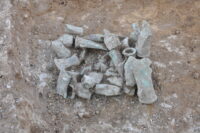 A teenage metal detectorist has discovered a Bronze Age axe hoard in a field near Royston, Hertfordshire. The hoard was discovered by 13-year-old Milly Hardwick who was metal detecting for just the third time accompanied by her father Colin. When her machine gave a strong signal, her father started digging and unearthed a bronze axe. They dug up about 20 bronze pieces before reporting their discovery and covering up the find site.
A teenage metal detectorist has discovered a Bronze Age axe hoard in a field near Royston, Hertfordshire. The hoard was discovered by 13-year-old Milly Hardwick who was metal detecting for just the third time accompanied by her father Colin. When her machine gave a strong signal, her father started digging and unearthed a bronze axe. They dug up about 20 bronze pieces before reporting their discovery and covering up the find site.
The next day, county archaeologists excavated the site and found an additional 45 objects for a total of 65 Middle Bronze Age artifacts including socket axe heads, winged axe heads, cake ingots and blades/blade fragments. They date to around 1300 B.C.
Archaeologists then discovered a second hoard just eight feet away from where the first axe was unearthed. The second hoard was even larger with 135 objects. The two hoards appear to have been buried separately, but may be related in some way.
“The find was reported to county council archaeologists who subsequently worked with Oxford Archaeology East to ensure full and proper recovery of the hoards. The items now await further study, after which a report will be submitted to the coroner.
“If what has been found is declared treasure by the coroner and if a museum wishes to acquire the hoard, then the finder and landowner will be eligible to claim a reward. The value of this will determined by the Secretary of State, as advised by the independent Treasure Valuation Committee.
“This is of course a very exciting discovery, but we are unable to say anything further until investigations have concluded.”
The exact location of the find is being kept under wraps, to ensure the site remains intact.
In the second photo, what are the pieces of paper in the corners of the excavation?
My personal guess would be “markers”, similar to when you have X-ray done, i.e. in order to make “directions of view” a bit more clear, not that –by mistake– the wrong arm is taken off, when people leave hospital.
It might even be that those four spots had been GPS-positioned, but frankly I have likewise no idea, what those outside “greyish fields” or “arcs” on the papers are supposed to mean exactly. Photo colour settings e.g. might come to mind.
In TWO dimensions, it is possible to “stitch together” several photos –if taken in correct manner– into a “panoramic picture”. So more guesswork: Something similar MIGHT(!) be possible in THREE dimensions.
Hence -if so- those marks would be used in an algorithm, cf.:
en.wikipedia.org/wiki/3d_scanner#From_photographs
:hattip: